| 〔Original Paper〕 |
Decision Making, Working Memory, and the Effects of Learning:
A comparative analysis of near-infrared spectroscopy analyses of the frontal lobe and self-reported subject responses |
|
| Fumiko Sato1), Ichiro Shimoyama2) and Shoko Shibukawa3) |
| (Received August 2, 2006, Accepted October 30, 2006) |
|
SUMMARY
The purpose of this research is to study the development of decision-making abilities between educated and non-educated groups, analyzing blood flow changes over the frontal lobes. Neural activation was estimated with infra-red spectroscopy. The educated subjects were of 3 undergraduates majoring in Home Economics with cooking lesson experience, and the non-educated subjects were of 5 other undergraduates not majoring in Home Economics. A task was projected on a screen for 30 s in a series of 30 questionnaires alternatively, composed of educated questions and non-educated questions. And subjects were asked to make a decision as fast as he/she could, and in case of no decision the subjects were asked to no more think. Just after the measuring a comprehension-test was done.
The Oxy-hemoglobin dynamics showed different frontal lobe activation between the 2 groups. Education might activate the frontal lobes in decision-making. |
|
Key Words
| Decision making, Education, Working memory |
|
| |
I. Introduction
Decision making[1]is a general capability involving all of the three processes of problem recognition, comparison against memory, and passing of judgment. In education[2]and medicine[1], decision making is considered to be a crucial ability in society. The role played by working memory[3,4]in decision making is a large one, and it is classified as a general higher-order brain function in which an agent brings together all the skills he or she has learned to make a value judgment and then act upon that judgment.
Today a great deal of objective research has begun to appear in which analysis of brain waves and blood flows in the brain are used to analyze linguistic skills[5-9]. Research reports have been published describing the language capabilities of the frontal lobe and describing the mechanisms underlying the recognition of contexts and pictures[10]. While the concept of working memory as proposed in 1974 by Radvansky GA and Copeland D[3]also bears a close relationship to short-term memory and the processes by which answers are obtained through internal language by the vitalization of long-term memory to recall things already learned upon the presentation of visual stimuli and the understanding of context and recognition of pictures and understanding of provided instructions are complicated ones, the participation of the frontal association area has been reported in the performance of all of these processes, and here we accordingly consider primarily Brodmann area 46[10-12].
As a working hypothesis, we adopted the hypothesis that learning increases levels of activity in the frontal lobes in decision making, and brain activity was measured using near-infrared spectroscopy and the results obtained were then compared against self-reported answers given before and after the experiment..
II. Materials and Methods
(1) Subjects
Data were recorded and analyzed from university-level students: 3 female students who had taken classes in cooking and majoring in home economics (ages 21-23) , and five volunteer students with majors other than home economics (3 females and 2 males, ages 21-23) . The nature of the experiment was fully explained to the subjects before beginning recording, and after obtaining assent the subjects signed forms of agreement before participating in the experiments.
(2) Problems
Before beginning actual measurements, preliminary tests on control problems were conducted. The control problems were designed so as to be problems in which not only selected subjects would display interest or possess a strong awareness, but rather one in which all subjects would have approximately the same level of interest and awareness and in which the level of difficulty of the problems could be varied. The subjects used here consisted of subjects who were not subjects in the main experiment. After trying sports, still-life and landscape photographs, origami, and other candidate topics as problems in which the subjects could be expected to display the most similar level of interest and involvement, it was found that origami was the subject in which the subjects displayed the most similar level of interest and involvement and the results obtained also showed that it is easy to vary the level of difficulty, and origami was accordingly chosen as the control problem.
As specialized problems, problems were chosen covering the process of decision making in cooking, and these problems were presented in alternation with the control problems. (Table 1)
The subjects were instructed to respond to the problems as quickly as possible as they were shown in internal language without accompanying speech motions, i.e., to answer silently in their heads, and they were instructed not to think too deeply or try to force themselves to respond.
(3) Methodology
Measurements were taken in a dimly lit shield room where no external noise could be heard. Subjects were seated in chairs placed 1.2 meters away from a screen (1.2 X 0.8 meters) with their heads fixed into place, and measuring probes were attached evenly to the left and right sides of the front of the head. (See Figure 1) Measurements were taken from 45 channels of measuring points.
The measuring instrument was used to irradiate the scalp with near infrared rays of 780, 805, and 830 nanometers, the reflected light was measured at 220-msec intervals at a distance of 3 centimeters, and this was used to calculate the variations in oxygenated hemoglobin, deoxygenated hemoglobin, and total hemoglobin. (Measurements were taken in mmol X cm using an NIRStation near-infrared monitor.)
Stimuli were projected from a liquid-crystal project located 2.4 meters to the rear, 30 problems consisting of a text question and a picture within a single frame were created, and a personal computer was used to control projection with specialized problems and control problems displayed alternately at 30-second intervals.
Immediately after the completion of recording, the same pictures as those used as stimulus problems were shown to the subjects to accurately recreate the same answers as those the subjects had answered mentally in their heads, and subjects were then requested to record their own answers.
|
Table 1 Types of problems
|
No.
|
Decision-making process
|
Purpose of question
|
| I | Process of preparing for solution of problem | Opening of question |
| II | Process of checking resources and information for decision making (general cooking questions) | Desire and interest in cooking Personal information resources (knowledge) on cooking |
| III | Processing of checking resources and information for decision making (everyday life) | Non-specific desire and interest in everyday issues Non-specific personal information resources (knowledge) on everyday life |
| IV | Process of marshalling resources and information for decision making (specific everyday skills/general abili- ty regarding cooking) | Personal information resources specific to cooking (knowledge, technique, overall capabilities) |
| V | Processing of marshalling resources and information for decision making (overall capabilities concerning examples of general practice in everyday life) | Personal information resources not specific to everyday life (knowledge, technique, overall capabilities) |
| XX | Process in decision making in which one considers possible developments from multiple choices and compares and considers the possibilities (specific everyday skills/general ability regarding cooking) | Consideration of possible developments from multiple choices specific to cooking and comparison and consideration of possible alternatives (knowledge, technique, overall capabilities) |
|
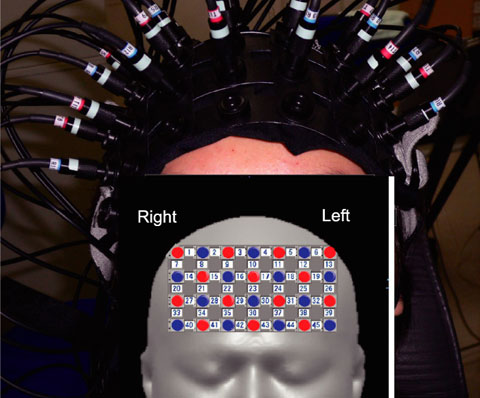 |
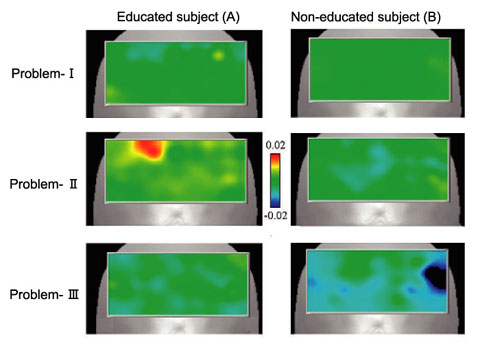 |
Fig. 1
Sample placement of probes. Red dots indicate emitters, blue dots receptors. Numbers indicate measuring channels. |
Fig. 2
Representative example of topography for problems I-III. Color bar units are in mmol X cm.
|
|
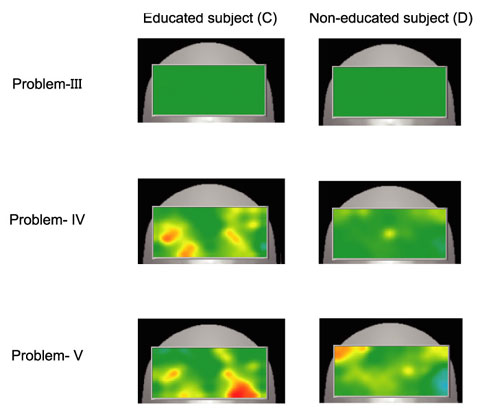 |
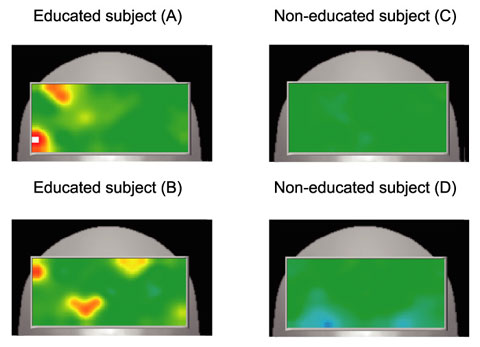 |
Fig. 3
Representative example of topography for problems III-V. Color bar units are in mmol X cm. |
Fig. 4
Representative example of topography for problem XX. Color bar units are in mmol X cm.
|
|
III. Results
(1) A comparison of topographies between educated and non-educated subjects
A representative example of the topography of oxygenated hemoglobin in educated and non-educated subjects is shown together with a pseudo-color bar in Figure 2 (The warmer colors represent higher values, and the cooler colors represent lower ones. The pictures are taken from in front of the subjects' foreheads, and the right side represents the left brains of the subjects.) For educated subject A (shown on the left) , a slight increase in oxygenated hemoglobin can be seen in the upper left on Problem I, and in Problem II an increase over a wide range could be observed in the upper right.
For non-educated subject B (shown on the right) no overall changes could be seen, and for Problem II a slight decrease in oxygenated hemoglobin can be seen in the center. A further decrease can be observed on the left in Problem III, and a widespread overall decrease in oxygenated hemoglobin can be seen on the right as well.
In Figure 3, while results for educated subject C show that the color overall remains even and shows no change throughout the frontal area, significant increases could be seen over a wide area in problem IV in two locations in the right frontal lobe and in the left frontal lobe. In Problem V, strong increases could be seen in the lower part of the left frontal lobe and slight increases seen in the lower right and middle.
For non-educated subject D, no change could be seen on problem III, and even on problem IV only a slight increase could be seen in the center and to the left and right, and a small decrease could be seen on the lower right. On problem V, it can be surmised that there was an increase in oxygenated hemoglobin in the center, and a decrease could be seen in the lower left.
Figure 4 shows the results of the decision making process when subjects were presented with the question, "What problems have you encountered (do you encounter) both when making curry and when making simmered beef and potatoes, or, alternatively, what problems have you encountered (do you encounter) in making each?” For educated subject A, an increase could be seen to the upper and lower right, and the increase on the lower right was particularly large. A slight increase can also be seen somewhere near the right center. For educated subject B, increases can be seen on the upper right, to the lower right of center, and near the upper middle left. In contrast to this, however, almost no increase could be seen in non-educated subject C. Similarly, no increase could be seen with non-educated subject D, and a decrease was observed at the lower left and right.
(2) An examination of changes in levels of oxygenated hemoglobin over time induced by specialized and control problems (Figure 5)
Figure 5 shows the differences over time in oxygenated hemoglobin between a pair of contrasting problems presented in succession. Areas in which levels of oxygenated hemoglobin were higher for a specialized problem than a control problem are indicated in red, and areas where such levels are lower are indicated in blue. The horizontal axis represents the amount of elapsed time covering a total of 30 seconds, with the dotted line indicating the point at which 15 seconds have elapsed. The vertical axis represents the amount of increase of oxygenated hemoglobin. The data for each subject represents data from 45 channels of the frontal lobes, with the data to the left and right representing data for home economics majors (i.e., educated subjects) and non-educated subjects, and the upper and lower lines represent contrasting types of problems. In the contrastive problems at the top, the red portions for educated subjects indicate slight spindle-shaped increases and decreases centered around the 15-second point which could be seen locally at the upper part of the left lobe, and in the right lobe decreases could be seen for the contrastive problems. While an increase in red can be seen over a wide area for the upper?row problems for non-educated subjects, for these subjects no great levels of concentration could be seen and increases were seen through a wide area of the frontal lobe. Note that this is also due to a large decrease for contrastive problems. In the contrastive problems at the bottom, a greater spindle-shaped increase in oxygenated hemoglobin could be seen for specialized problems than for contrastive problems in both non-educated and educated subjects. A spindle shape was thicker for educated subjects and greater increases were seen. Decreases were seen at the lower right for non-educated subjects.
(3) A comparison of non-educated subjects and educated subjects through self-reporting
As an overall trend, when non-educated and educated subjects are compared, educated subjects outperformed non-educated subjects in terms of both quantity and quality when presented with text information at all stages of the decision making process.
A look at the answers supplied by subjects to problem IV (i.e., "Name as many dishes as you can you have already made”) shows that while educated subjects A' s and B' s responses listed a greater variety of names of dishes which were more difficult to cook, i.e., educated subject A listed ‘curry, stew, simmered beef and potatoes, vegetable soup, soy-sauce spinach, steamed rice and fillings, dumplings, salads, pilaf, and rice-paste pizza' and educated subject B listed ‘hamburgers, curry, stew, simmered beef and potatoes, Caesar salad, dumplings, floury potatoes, carrots glac?, radish-flavored rice, rolled sushi, bavarois (Bavarian cream) , gelatin, sauted Okinawan cucumber salad, and bean curd cake' , non-educated subjects A and B listed names of dishes which were comparatively easier to make, with non-educated subject A listing ‘sunny-side-up eggs, fried rice, rice omelettes, and mixed cabbage and egg pancakes' and non-educated subject B listing ‘fried rice, fried bacon and potatoes, spaghetti, and sandwiches'
Figure 4 shows the results of the decision making process when subjects were presented with the question, "What problems have you encountered (do you encounter) both when making curry and when making simmered beef and potatoes, or, alternatively, what problems have you encountered (do you encounter) in making each?”
In the self-reported answers provided to question XX, "What problems have you encountered (do you encounter) both when making curry and when making simmered beef and potatoes, or, alternatively, what problems have you encountered (do you encounter) in making each?”, educated subject A' s response, i.e., ‘Pot, little space for washing, mushy potatoes, lingering smell of curry' , listed details which would be difficult to describe without experience in actual cooking and listed the main requirements needed for making selections. Educated subject B' s response noted that ‘it is a bother to saut onions properly, skimming scum…, difficult to achieve proper consistency' , thus describing major things learned from actual experience. In contrast, non-educated subject C' s response listed ‘peeling potatoes and slicing vegetables' , thus indicating no apparent experience in making these dishes and listing only beginning and fragmentary cooking operations. Non-educated subject D listed only ‘unable to properly soften carrots' .
|
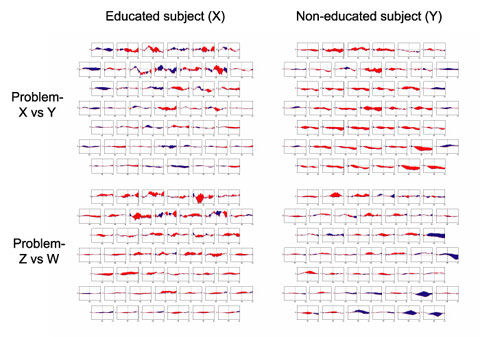 |
Fig. 5 Representative example of dynamics of oxygenated hemoglobin over 30-second interval. Units of oxygen consumption (mmol X cm) have been set to match table above.
|
|
IV. Discussion
Within the decision-making process as a whole, Problem I may be considered as a preparatory stage in which one is considering what to do next, and we therefore view it as a preparatory stage prior to the rest of the problem. Problem II is a problem where one has to gather together information about cooking, and is viewed as a general preparatory information-collecting stage in cooking in which the decision-making process consists of the gathering of resources and confirmation of information. Problem III was created to serve as a control question for the experiment, and its level of difficulty was set as the same as that of Problem II. Within the decision-making process as a whole, it represents the process of marshalling one' s resources and information for the making of decisions in everyday life. The process by which one marshals together all one' s capabilities (resources) and information and all the necessary knowledge about food, is a process in which the brain functions to bring together everything one has learned, and it is as viewed as an important stage of working memory.
From the results shown in Figures 3 and 5, it can be seen that while no change in activity could be seen in problem I, which was used as a control problem (i.e., involving ordinary circumstances) for both non-educated and educated subjects, during the process of preparing for problem-solving, with problem II a particularly high level of stimulation of neural activity could be judged to occur in the right frontal lobes of educated subjects, and widespread activation could be judged to occur throughout the left and right frontal lobes as a whole. In contrast to this, the level of stimulation of activity for non-educated subjects was minimal in problem II, and it is estimated that the levels of activation were even lower for problem III than for problem I.
It can be surmised that the use of working memory is the reason why increased activity could be seen in the left and right frontal lobes of educated subjects when presented with problem II (which was about home economics in particular) even though no differences could be seen between subjects A and B when presented with problem I (which was not about home economics in particular) . These results agree with reports of patients who have suffered damage to the right frontal lobe. 4
Figure 3 may be considered to be a view of the process whereby required information is gradually identified during the process of information gathering. While almost no change may be seen throughout the frontal lobe on problem III for educated subject A, on problem IV there are indications of increased activity in the lower part of the right frontal lobe and over a wide area in the left lobe.
These results show that while no change in levels of activity can be observed on problem III, which was used as a control problem (i.e., involving ordinary circumstances) for both non-educated and educated subjects, with problem IV there are indications of particular strong neural activity created in educated subjects in the left frontal lobe, as well as indications of the creation of widespread activity throughout the left and right frontal lobes overall. In contrast to this, the amount of stimulation with problem IV for non-educated subjects is quite small, and with problem V stimulation could be observed in both groups.
Problem IV is here viewed as representing the marshalling of existing resources when faced with a specialized real-life task to perform (here, cooking) , the process of gathering information resources as a part of decision making, and it is viewed as an important part of the overall process of decision making. It may be inferred that the reason why increased activity may be seen during this process in educated subjects is because a great deal of activity is taking place during the process of gathering together all the knowledge, skills, and other things which have thus far been learned, and we conclude that this process barely takes place at all with non-educated subjects.
Figure 4 shows subjects as they are required to make a decision in accordance with circumstances which requires them to call together all of the resources and knowledge they possess. We believe that this figure shows the differences in reactions between non-educated and educated cooks in this higher-order process, i.e., a process in which multiple methods and what happens with each must be considered.
From these results, large differences can be inferred to exist in levels of activation between non-educated and educated subjects in the decision-making process where subjects are requested to consider multiple methods and what happens with each, a problem used to provide a comparison between non-educated and educated subjects. For educated subjects, particularly high levels of neural stimulation could be seen primarily in the right lobe, and a widespread increase in stimulation could be seen throughout both the left and right lobes.
In contrast to this, virtually no stimulation of activity could be seen in non-educated subjects, and even lowered levels of activation could also be seen in places, thus leading us to conclude that major differences exist between the two groups.
And also as an overall trend, when non-educated and educated subjects are compared, educated subjects outperformed non-educated subjects in terms of both quantity and quality when presented with text information at all stages of the decision making process.
In the above, we have obtained results through these experiments which support our hypothesis that learning increases levels of activity in the frontal lobes in decision making, and we have reason to hope that learning can be used to improve the decision making process.
Acknowledgments
We would like to the Shimadzu Corporation for their cooperation in allowing us the use of a near-infrared spectroscope.
|
|
要旨
本研究の目的は,前頭葉の血流の変化を解析することによって,調理学習履修者と未履修者間の意思決定能力形成の差を追究することである。脳機能の活性化は,近赤外線スペクトロスコピー法を用いて計測した。被験者は,家庭科専攻で調理学習を履修した学生3名,家庭科専攻以外の学生5名である。刺激課題は液晶プロジェクターから投射し,質問文と絵を1画面に納めた30問作成して専攻課題と対照課題を交互に30秒ごとに提示した。刺激課題は出来るだけ早く意思決定して回答してもらい,決定出来ない場合には無理に回答しないように要求した。記録終了直後に刺激課題と同じ描画を1枚ずつ見せて頭の中で回答したことを正確に再現し自己申告記録してもらった。この結果,調理学習既習者は,非既習者に比して,前頭葉における酸素化ヘモグロビンの活性化がみられ,意思決定能力の形成が認められた。
|
|
References
1) Shapiro J. Training the clinical eye and mind: using the arts to develop medical students' observational and pattern recognition skills. Medical Education 2006; 40: 263-8.
2) Science Council of Japan Liaison Committee for Research in Formal Education, ed. (2001) New Ways of Learning and the Role of Formal Education.Tokyo: Toyokan Shuppan 2001; 49-56.
3) Radvansky GA, Gabriel AR, Copeland D. Memory retrieval and interference: Working memory issues. Journal of Memory & Language 2006; 55: 33-46.
4) Chudasama Y, Robbins TW. Functions of frontostriatal systems in cognition: Comparative neuropsychopharmacological studies in rats, monkeys and humans. Biol Psychol 2006; 73: 19-38.
5) Shimoyama I, Nakajima Y, Ito T, Shibata T. Visual evoked potentials relating to imagery: words for concrete objects versus absolute concepts. Brain Topogr 1997; 9: 271-5[Pubmed].
6) Fujimaki N, Hayakawa T, Matani A, Okabe Y. Right-lateralized neural activity during inner speech repeated by cues. Neuroreport 2004; 15: 2341-5.
7) Stein MT, Marx NR, Beard J Jr, Lerner M, Levin B, Glascoe FP, Zweiback M, Schechtman M, McInerny TK. ADHD: the diagnostic process from different perspectives. J Dev Behav Pediatr 2004; 25: S54-8.[Pubmed]
8) Im CH, Jung HK, Fujimaki N. fMRI-constrained MEG source imaging and consideration of fMRI invisible sources. Hum Brain Mapp 2005; 26: 110-8.[Pubmed]
9) Lee D, Sawrie SM, Simos PG, Killen J, Knowlton RC. Reliability of language mapping with magnetic source imaging in epilepsy surgery candidates. Epilepsy Behav 2006; 8: 742-9.
10) Gomez-Beldarrain M, Harries C, Garcia-Monco JC, Ballus E, Grafman J. Patients with Right Frontal Lesions are Unable to Assess and Use Advice to Make Predictive Judgments. J Cogn Neurosci 2004; 16: 74-89.
11) Van Petten C, Luka BJ. Neural localization of semantic context effects in electromagnetic and hemodynamic studies. Brain Lang 2006; 97: 279-93.[Pubmed]
12) Brown S,Martinez M,Parsons LM. Music and language side by side in the brain: a PET study of the generation of melodies and sentences. European Journal of Neuroscience 2006; 23: 2791-803.[Pubmed]
|
|
Others
1) Faculty of Education, Chiba University, Chiba 263-8522.
2) Research Center for Frontier Medical Engineering, Chiba University, Chiba 263-8522.
3) Faculty of Humanities, Seitoku University, Chiba 271-8555.
佐藤文子,下山一郎,渋川祥子: 既習者と非既習者の意思決定過程における前頭部近赤外スペクトル解析.
1) 千葉大学教育学部
2) 千葉大学フロンティアメディカル工学研究開発センター
3) 聖徳大学人文学部
Tel & Fax. 043-290-2591.
2006年8月2日受付,2006年10月30日受理.
|
|
|
|
|
|
|
|
|
|